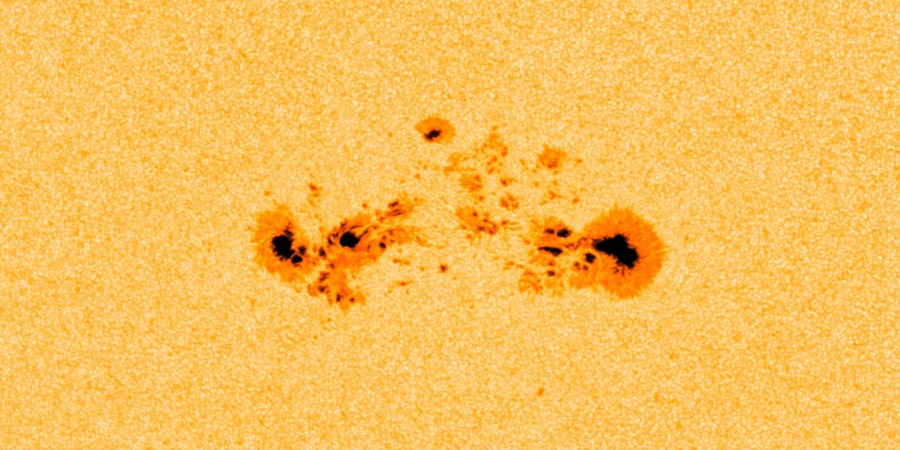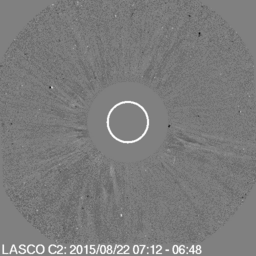More solar flares from sunspot region 2403
Saturday, 22 August 2015 18:29 UTC

Sunspot region 2403 remains the most complex sunspot region on the earth-facing solar disk and is producing M-class solar flares. It has been the source of two M-class events today: M1.2 and M2.2.
The M1.2 solar flare peaked this morning at 06:49 UTC and was associated with both Type II and IV radio sweeps indicating that a coronal mass ejection might have been launched.
Moderately strong M1.23 solar #flare - Follow live on http://t.co/XHATH0OOfT pic.twitter.com/AQQ6EC7Ydf
— SpaceWeatherLive (@_SpaceWeather_) 22 augustus 2015
ALERT: Type II Radio Emission Begin Time: 2015 Aug 22 0650 UTC Estimated Velocity: 1149 km/s
ALERT: Type IV Radio Emission Begin Time: 2015 Aug 22 0656 UTC
SOHO coronagraph imagery indeed shows us that there was a coronal mass ejection associated with this event. The coronal mass ejection again looks rather faint, and expands to form a partial halo of about 180 degrees. This coronal mass ejection looks very similar to yesterday's event as it also moves fairly slow. While we do think that this plasma cloud could give us a glancing blow due to the partial halo formation of about 180 to 200 degrees, any impact at Earth should just like yesterday's event be minor. Our best bet is to hope for a stronger solar flare which we hope give us a stronger and faster coronal mass ejection. It is unlikely that the events of today and yesterday will leave a noticable trace in the solar wind at Earth.
Image: SOHO/LASCO C2 animation of the M1.2 coronal mass ejection.
M2.2 solar flare
Today's M2.2 solar flare was a rather impulsive event and did not launch a coronal mass ejection.
Sunspot region 2403
Sunspot region 2403 keep it's Beta-Gamma-Delta magnetic layout but it is showing signs of magnetic separation as the large trailing and leading sunspot clusters drift apart. The group is still in a phase of growth. While some spots disappeared, there was still a very decent amount of growth to be seen in the previous 24 hours. A small delta structure formed among the trailing sunspots which hopefully continues to grow in the next 24 hours. Another low-level (R1) solar flare can not be excluded but higher M-class or X-class solar flares are unlikely at this point due to magnetic seperation and the modest size of the trailing delta sunspot. For solar flares exceding the M5-class we need this group to regain some magnetic complexity.
Visit our sunspot region page for the most actual imagery of the current sunspot regions, including sunspot region 2403. Click here to go to the page.
Thank you for reading this article! Did you have any trouble with the technical terms used in this article? Our help section is the place to be where you can find in-depth articles, a FAQ and a list with common abbreviations. Still puzzled? Just post on our forum where we will help you the best we can!
Latest news
Latest forum messages
Support SpaceWeatherLive.com!
A lot of people come to SpaceWeatherLive to follow the Sun's activity or if there is aurora to be seen, but with more traffic comes higher server costs. Consider a donation if you enjoy SpaceWeatherLive so we can keep the website online!

Space weather facts
| Last X-flare | 2024/03/28 | X1.1 |
| Last M-flare | 2024/04/19 | M1.0 |
| Last geomagnetic storm | 2024/04/16 | Kp5 (G1) |
| Spotless days | |
|---|---|
| Last spotless day | 2022/06/08 |
| Monthly mean Sunspot Number | |
|---|---|
| March 2024 | 104.9 -19.8 |



